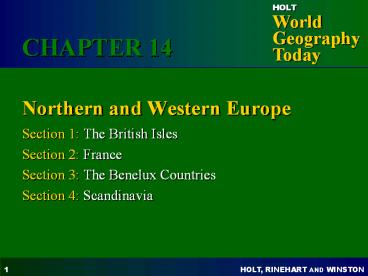Northern%20and%20Western%20Europe - PowerPoint PPT Presentation
Title:
Northern%20and%20Western%20Europe
Description:
CHAPTER 14 Northern and Western Europe Section 1: The British Isles Section 2: France Section 3: The Benelux Countries Section 4: Scandinavia * * Objectives: How has ... – PowerPoint PPT presentation
Number of Views:109
Avg rating:3.0/5.0
Title: Northern%20and%20Western%20Europe
1
Northern and Western Europe
CHAPTER 14
- Section 1 The British Isles
- Section 2 France
- Section 3 The Benelux Countries
- Section 4 Scandinavia
2
Objectives
Section 1 The British Isles
- How has history affected the culture of the
British Isles? - Why are the cultures of Ireland and the United
Kingdom similar? - How has the British economy changed over the last
200 years? - What issue has caused tension in Northern Ireland?
3
A. Effects of history on the culture
I. The British Isles
- 1. 5,000 years ago, earliest settlers,
Stonehenge. - 2. Later, Celtsthe ancestors of Scots, Welsh,
and Irishoccupied England. - 3. Romans arrived and built towns.
- 4. Angles and Saxons came, drove Celts to
highland Britain. - 5. Vikings raided and built coastal settlements.
- 6. Norman conquest of 1066 brought French
influence.
4
B. Similarities of Ireland and the United
Kingdom
I. The British Isles
- 1.Social life centers on local eateries.
- 2. Same Sports soccer, rugby, and cricket
- 3. English is main language.
5
C. Changes in the British economy
I. The British Isles
- 1. Britain industrialized in early 1800s.
- 2. It dominated global trade through much of the
1800s. - 3. By 1900 Britain had lost its dominance mines
and industries declined. - 4. Britain nationalized many industries after
World War II then privatized again. - 5. Today the economy is strong high tech
industries, oil and gas, services, tourism.
6
D. Tensions in Northern Ireland
I. The British Isles
- 1. Division between Protestants and Catholics
has brought violence. - 2. Britain has tried to keep peace.
- 3. 1998 agreement set up shared government, but
future is unclear.
7
Objectives
Section 2 France
- What is French culture like?
- What are some of the main industries in France?
- What challenges does France face today?
8
Features of French culture
Section 2 France
- strong identity united by language and religion
- mainly Roman Catholic
- concern about American influence
- strong desire to preserve customs
9
Major industries
Section 2 France
- fashion design
- perfume and cosmetics
- jewelry, glassware, furniture
- tourism
- high-techaviation, communications, space
technology
10
Challenges
Section 2 France
- privatizationconverting state-owned businesses
brings unemployment - immigrationintegrating migrants from North
Africa, Asia, West Africa - colonial empiremaintaining ties without unrest
or violence
11
Objectives
Section 3 The Benelux Countries
- What historical ties do the Benelux countries
share? - What are the cities and economies of the Benelux
countries like?
12
Historical ties
Section 3 The Benelux Countries
- once part of the Netherlands
- invaded by foreign powers
- political and economic union after World War II
13
Cities and economy of Belgium
Section 3 The Benelux Countries
- Brusselscosmopolitan capital headquarters of
EU, NATO - Antwerpsecond city of Belgium key port
- industry, agriculture, services for international
business
14
Cities and economy of the Netherlands
Section 3 The Benelux Countries
- diversified economyagriculture (dairy, flowers),
exports, natural gas - urbanized area (Randstad) includes major
citiesAmsterdam (capital), Rotterdam (key port),
The Hague (Parliament, International Court of
Justice)
15
Economy of Luxembourg
Section 3 The Benelux Countries
- highest per capita GDP in world36,400
- traditional steel producer international banking
now more important
16
Objectives
II. Scandinavia
- How are the cultures of Scandinavia similar to
and different from each other? - What does the economy of this region rely on?
- In what areas do most people in Scandinavia live?
17
A. Scandinavian cultures
Section 4Scandinavia
- Similarities
- religionmainly Protestant Lutheran
- most languages related
- democratic governments
- Differences
- Finnish language not related to others
- Lapps a distinct culture
18
Economic foundations
Section 4Scandinavia
- high-tech industries and export-oriented
economies - commercial agriculture in Denmark
- forest products in Sweden
- fishing in Iceland and Norway
- offshore oil and gas in Norway
19
Settlement patterns
Section 4Scandinavia
- Most people live in southern parts of countries,
where climate is warmer. - 85 percent of Swedes live in cities.
- One-fourth of Danes and Norwegians live in or
around capital cities. - Most Finns live near Helsinki.
- People in Greenland and Iceland live near coast.






























